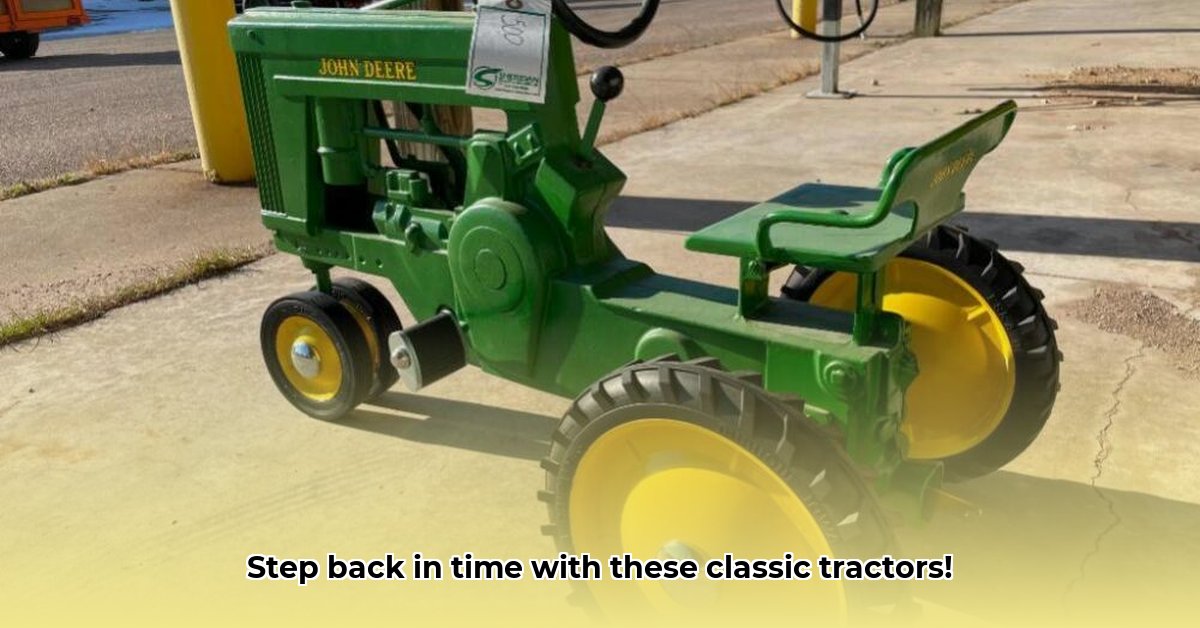
These iconic green and yellow pedal tractors aren't just toys; they're miniature works of art, encapsulating a nostalgic era of American ingenuity. For even more information on John Deere pedal tractors, check out this helpful resource: John Deere Toy Tractors. This comprehensive guide will help you navigate the world of vintage John Deere pedal tractors, whether you're a seasoned collector, a prospective buyer, or looking to sell your family heirloom. We'll cover everything from assessing condition and identifying desirable models to the finer points of restoration and sourcing parts. Let's get started!
Assessing Your Vintage John Deere Pedal Tractor: A Detailed Inspection
Before buying or selling, a thorough inspection is essential. This isn't just about finding flaws; it's about understanding the tractor's history and value. Think of it like a pre-purchase inspection for a classic car – only smaller and, arguably, even more charming.
Paint and Decals: A Visual Story: Begin by scrutinizing the paint for chips, scratches, rust, and fading. Decal condition is equally critical. Are they crisp and intact, or cracked, peeling, or missing? Excellent preservation here significantly boosts value. Damaged paint and decals hint at a harsher life, impacting the overall worth.
Tires: Rolling Through Time: Inspect the tires for wear, cracks, and missing treads. Are the wheels straight and firmly attached? Worn tires are relatively easy to replace; however, missing or severely damaged ones present more significant challenges. Original, well-preserved tires greatly enhance a collector's piece.
Functionality: Pedal Power Test: Test the pedals, steering wheel, and all moving parts. Do they operate smoothly, or are they stiff or stuck? A smoothly functioning tractor is far more desirable. Easy operation suggests proper maintenance; stiff or non-functional elements indicate the need for repairs or restoration.
Metal: Beyond Surface Appearance: Examine the metal body for dents, bends, or significant rust. Minor surface rust is often manageable; however, extensive rust significantly decreases the tractor's value. Minimal rust points to good care; widespread rust suggests potential exposure to elements and might require substantial restoration.
Completeness: Parts Inventory: Is the tractor complete? What parts are missing (pedals, seat, etc.)? A complete tractor is highly desirable; missing parts reduce both aesthetic appeal and value.
Top 5 Desirable 1950s John Deere Pedal Tractor Models
While all vintage John Deere pedal tractors possess charm, certain models are particularly sought-after by collectors. Rarity, unique design features, and overall desirability all play a role. Condition, however, remains the most crucial factor impacting a tractor's value.
Model 520: Often cited as one of the most desirable models, the 520 is known for its robust build quality and classic design.
Model 600: This model's increased size and relatively rare sun yellow paint scheme are particularly desirable features.
Model 730: Its unique appearance and relative scarcity in good condition make it a favorite among serious collectors.
Model 20: Simpler than many later models, enthusiasts admire the earlier Model 20 for its streamlined design.
Model 4020: This later model features more complex details compared to its predecessors, making it especially valuable to collectors appreciating such details.
Restoring Your 1950s John Deere Pedal Tractor: A Step-by-Step Guide
Restoring a vintage tractor is a rewarding but demanding process. This guide provides a general overview; specific needs will vary depending on your tractor's condition.
Step 1: Meticulous Disassembly: Carefully disassemble the tractor, documenting each step with photos. Label and store all parts meticulously.
Step 2: Thorough Cleaning: Clean each component using appropriate brushes, solvents, and potentially compressed air for difficult-to-reach areas.
Step 3: Repair or Replacement: Repair repairable parts. For beyond-repair items, source high-quality replacement parts (see below for resources).
Step 4: Painstaking Reassembly: Reassemble the tractor, referring to your photos. Test functionality at each stage.
Step 5: Protective Finish: Apply a protective coat of paint or sealant (if needed) to preserve your restored tractor.
Sourcing Parts and Information: Building Your Network
Finding parts and information for your restoration project is easier than you might think. A supportive community exists, ready to assist your efforts.
| Resource Type | Examples | Benefits |
|---|---|---|
| Online Marketplaces | eBay, Etsy, specialized online toy marketplaces | Wide selection, but always verify seller ratings and authenticity. |
| Specialized Retailers | Vintage toy stores (local and online) | Often carry specific parts and offer expert advice. |
| Online Forums | Forums focused on vintage toys | Wealth of information from fellow collectors, excellent for troubleshooting. |
Market Overview: Values and Trends
The market for 1950s John Deere pedal tractors remains active. Collector interest is strong, driven by nostalgia and the tractors' inherent charm. Condition is king; a pristine, original tractor will always command a higher price than a restored or heavily worn one.
Risk Assessment: Buying and Selling
Buying and selling vintage tractors involves some risks:
| Risk Factor | Likelihood | Impact | Mitigation Strategy |
|---|---|---|---|
| Counterfeit Parts | Medium | High | Buy from reputable sources; verify originality whenever possible |
| Overpaying for poor condition | High | Medium | Thorough inspection; consider professional appraisal |
| Market Volatility | Low | Low | Monitor market trends |
| Damage during Shipping | Low | Medium | Use robust packaging and insurance when shipping |
Careful research and thorough assessment are crucial for successful buying and selling. Happy collecting!